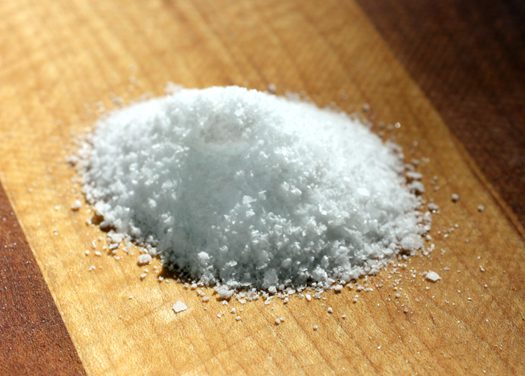All about salt
February 8, 2024 by DarcieWhen I first learned how to cook, I was aware of only one kind of salt, the stuff that came in the cardboard can that featured the iconic girl with an umbrella. It was Morton’s iodized table salt, and it’s all I used for years. As I learned more about cooking, I became aware of different types of salt: first sea salt, then kosher salt, then a cascade of brands and types all the way to a small vial of Antarctic sea salt that a friend who worked at McMurdo Station kindly bestowed on me. At one time I probably had about a dozen kinds of salt residing in my pantry. Yet the more I explored these options, the less convinced I became that there are notable flavor differences between the various salts being marketed for their [insert desirable characteristic], at price points that boggle the mind.

Today Melissa Clark took a deep dive into the world of salt (gift link). She describes the differences between salt by type (sea salt, kosher salt, table salt) and by brand (Maldon and Fleur de Sel de Camargue get glowing reviews). But, as with most people who wax poetic about specific salt varieties, Clark makes assertions about the flavors that are more romantic than they are accurate. Cook’s Illustrated demonstrated this in 2002, when they conducted a blind taste of nine different salts including plain Morton’s table salt (both iodized and non-iodized), the Fleur de Sel Camargue that Clark praises in the article, plus other sea and kosher salts. Cook’s found that “flavor differences were extremely subtle” and testers “felt that all nine salts tasted pretty much the same” when they were dissolved in water or chicken stock.
However, the testers did notice that that texture of the salt played a big role in how it was perceived. That is because according to Dr. Gary Beauchamp, director (in 2002 when Cook’s did the testing) of the Monell Chemical Senses Center in Philadelphia, “flat crystals or crystals with holes cause a taste sensation different from that of regularly shaped small crystals.” That textural difference is generally regarded as pleasing, at least when it comes to using it as a finishing salt. In Cook’s test, the irregular crystals of the Maldon and other flaky salts were off-putting when used in making biscuits, which testers described as “gritty” and unpleasant.
I doubt that even when used as a finishing salt, the “spicy” flavor that Clark attributes to Himalayan salt comes through to the vast majority of eaters. Unless you are snacking on the salt by itself, you are not likely to discern the subtle mineral differences between different brands. You will, however, notice the texture, so you’ll probably get as much out of Diamond or even Morton’s kosher salt as you would the more expensive brands. I admit a fondness for Maldon’s extra large crystals, although at $8 USD per 250g, I reserve it for special occasions. Even at that price it is an affordable luxury for most, so for that reason alone it’s no wonder specialty salt sales have skyrocketed in the last 20 years.
One thing Clark doesn’t bring up are the ethical and health considerations about salt. Studies have found that most sea salt is contaminated with microplastics. Commercially harvested sea salt has higher concentrations of these particles, but they have been found in virtually all brands. Salt mined from underground (which is also technically sea salt, albeit from ancient bodies of water) does not contain microplastics, but the company that makes chef’s favorite Diamond Crystal salt has a spotty environmental record and the company that owns Morton Salt has been labeled as a union-busting organization. Who knew buying salt could be so complicated?
Categories
- All Posts (7079)
- Antipasto (2209)
- Author Articles (250)
- Book News (944)
- Cookbook Giveaways (996)
- Cookbook Lovers (262)
- Cooking Tips (116)
- Culinary News (299)
- Food Biz People (558)
- Food Online (800)
- Holidays & Celebrations (277)
- New Cookbooks (154)
- Recipes (1520)
- Shelf Life With Susie (231)
- What's New on EYB (134)
Archives
Latest Comments
- lexa25 on For the Love of Lemons by Letitia Clark – Giveaway
- lexa25 on Balli Balli – Cookbook Giveaway and Quick Bites
- charcb on For the Love of Lemons by Letitia Clark – Giveaway
- charcb on Balli Balli – Cookbook Giveaway and Quick Bites
- Jane on Introducing libraries to EYB at ALA
- fluffies on For the Love of Lemons by Letitia Clark – Giveaway
- Goulashgirl on Any way you slice it
- ChefClaireFVS on French at Heart – Cookbook Giveaway
- ChefClaireFVS on 20 Amici – 40 Ricette Cookbook Giveaway
- kitchen_chick on Salt Sugar MSG Cookbook Giveaway